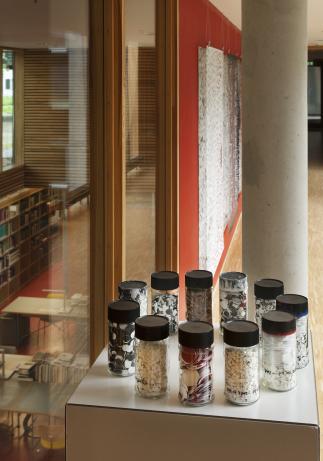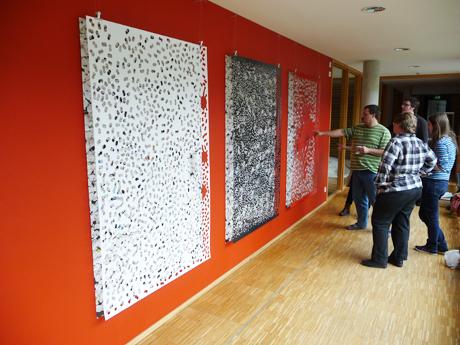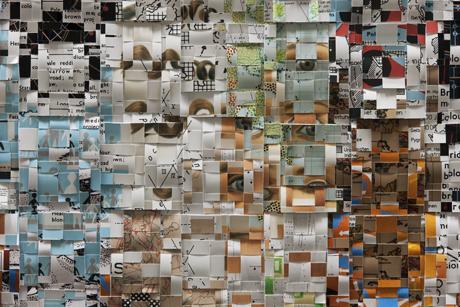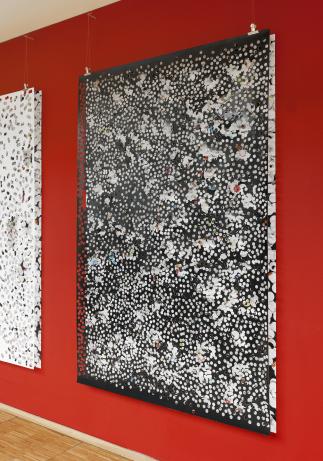The artist Katrin von Lehmann of Berlin was a guest of the Max Planck Research Group Twentieth Century Histories of Knowledge about Human Variation in 2012. The desire to collaborate with an artist arose while sifting through visualizations of human variety in the late twentieth century. From its creation this research group has examined these representations scientifically: First came a collaboration with Marianne Sommer, which culminated in the conference Visibility Matters: Rendering Human Origins and Diversity in Space and Time in Lucerne in April 2013.

Fig. 2: Blick auf Vielfalt, Serie 2, installation, photograph by Bernd Hiepe.
Second, the group set up a database of such visualizations, which now contains more than 500 images: family and phylogenetic trees, portrait collections, microscopic slides, tables, maps, diagrams, and many mixed forms of rendering. The database is supposed to give historians the opportunity to develop projects that, for instance, trace the history of a certain type of visualization, or show how images were reproduced nearly or completely unchanged in textbooks—and also traveled from textbook to textbook—over decades.
These images’ claim to truth, despite lip service to antiracism in the accompanying texts, generally boils down to the sentence “There are different human races”: apparently the authors of these texts hold this to be established knowledge. The persistent use of such images in educational media is highly problematic, for it reduces an enormously complex issue—human variation—to a seemingly plausible knowledge about “human races.” Observing these images may do more to reinforce deterministic views than to heighten awareness about the problem.

Fig. 3: Blick auf Vielfalt, Serie 3, photograph, perforation, photograph by Hartmut Kern.
Along with our interest in the aesthetic traditions of rendering these images, this awakened our desire for a non-deterministic portrayal of human variation that expresses its complexity, open-endedness, and dynamics, and thus the impossibility of its rendering. This was one of the topics of many conversations with Katrin von Lehmann, who then developed her own approach to the topic “Human Variation”: Emanating from the simple idea of a coloured pencil drawing underneath a perforated sheet of paper, she concentrates on the view in itself. There is only as much seen from the coloured pencil drawing as allowed by the holes in the perforated sheet. The rest of the drawing is covered; it exists, but is not visible. The directed view takes something into focus, on the other hand, blinds out something else.
This was not Katrin von Lehmann’s first confrontation with a scientific subject. In 2009 she dealt with what meteorologists call “observation by eye,” the practice of observing clouds in the sky and recording their shapes, translated into Latin terms, in a diary. Katrin von Lehmann used such cloud diaries for her complex of works entitled Augenbeobachtungen (observation with the eye).
As a guest of the Research Group at the MPIWG she created four groups of works: The series Blick auf Vielfalt 1-3 (Looking at Diversity 1-3), which focused on the practices of research on human variation and on scientific work in general, and World Citizen 1735-1990. The latter consists of a large-size, eight-layer, photographic weaving based on 20 images selected from the Visualizations of Human Diversity database.

Fig. 4: World Citizen 1735-1990, photographic weaving, photograph by Bernd Hiepe.
Katrin von Lehmann’s oeuvre is translation work: Its purpose is to convert a process that takes place over a certain temporal period into an image. The essential aspect of the process is visualization, not in a photographic snapshot, and not in the moving images of a film, but in an image like a substrate, as if all individual images in a film were superimposed onto each other. While the first translation involves rendering living processes into data, documents, or memory and storing them there, the second translation, the creative work, proceeds from the data, documents, or the memory to create an artistic equivalent, which transforms at the very moment of translation such that it cannot be read back. Lehmann’s work thus undergoes a process of abstraction—usually organized in strict strategic concepts. This work destroys in order to emphasize something new at the moment of destruction—be it as a shift, a new development, or a change in perspective.

Fig. 5: Blick auf Vielfalt, Serie 3, photograph, perforation, detail, photograph by Bernd Hiepe.
